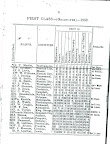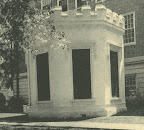
James Thomas Murfee (1833-1912) of Southampton County, Virginia, became the founder and first president of Marion Military Institute in 1887. Then president of Howard College (1871-1887) in Marion, COL Murfee and some trustees elected to stay in Marion and create Marion Military Institute following the decision to move Howard College to the new boom-town of Birmingham.
Col Murfee, who had begun the military program at Howard in 1871, graduated from the Virginia Military Institute, Lexington, in 1853 in civil engineering. As a cadet, he served as the First Captain (the highest ranking cadet) and graduated first in his class without a single demerit.
This is not Cadet First Captain J. T. Murfee, VMI Class of 1853, but rather the first captain in the Class of 1856. However, the image illustrates the dress uniform that Murfee would have worn. Note the Corps of Engineers emblem on the shako, similar to that worn at West Point during the period. (VMI Archives)

J. T. Murfee’s top standing in the VMI Class of 1853. (VMI Archives)

Entering the teaching profession, Murfee taught in Pennsylvania and Virginia before joining the University of Alabama in Tuscaloosa as a mathematics professor. With the outbreak of the Civil War in 1861, the University was militarized and the all-male student body became the Alabama Corps of Cadets (ACC). Murfee was originally second in command, but rose to become commandant of the ACC when his predecessor joined the Confederate forces. J. T. Murfee, himself, rose to the rank of lieutenant-colonel in the 41st Alabama Infantry.
The Round House at the University of Alabama (which still stands next to the Gorgas Library) was the only structure specifically built for military purposes, c. 1860-1861. It served as the cadet guard house and, ironically, was one of only four buildings to survive the destruction of the University in 1865. Its architecture is similar to that of the Virginia Military Institute. (Hoole Special Collections Library, University of Alabama)

As commandant, Murfee commanded the Alabama Corps of Cadets when Croxton’s raiders burned the University of Alabama on April 4, 1865. Alarmed that Union cavalry were in Tuscaloosa, the cadets were assembled and rushed through Tuscaloosa to defend the bridge at River Hill over the Black Warrior River. In a brief encounter with Union skirmishers near the bridge, two cadets and a tactical officer, State Captain John H. Murfee - COL Murfee’s brother - were wounded (Murfee, in the foot; three of the raiders were killed). Learning that their cannon had already been captured and that the cadets were badly outnumbered by a heavily armed opponent with artillery, the decision was made to retreat. While the enemy destroyed the University, the Alabama Corps of Cadets retreated along the Huntsville Road to Hurricane Creek where they barricaded the bridge and dug in along the opposite bank prepared to make a stand should the Union raiders follow them. The attack never came, however. COL Murfee then marched the Alabama Corps of Cadets down to Marion where they were disbanded, the war being essentially over.
After the Civil War, James T. Murfee worked as an architect in Tuscaloosa. As such, he was hired to help rebuild the University of Alabama. The first major structure built, what became Woods Hall, was designed by Murfee and was patterned after the barracks at his alma mater, the Virginia Military Institute. The building was to form part of a proposed quadrangle (modeled after VMI) which was never built. The Alabama Corps of Cadets continued as the mainstay of the student body during Reconstruction and beyond.
Woods Hall, built in 1868, was the principal University building until 1886, when two other buildings were constructed. (Hoole Special Collections Library, University of Alabama)

Note: Part Two will begin with James T. Murfee’s appointment as president of Howard College in Marion in 1871.